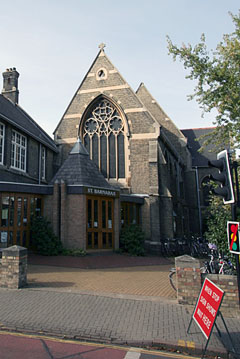St Barnabas was started in 1869 to house the increased population in this bit of Cambridge. Most of its contemporaries feel like they were thrown up in rather a hurry – St Philip, which is further down Mill Road over the railway bridge, is a case in point – but St Barnabas seems to have been designed with some grandeur in mind. It’s built of the familiar yellow bricks, but there are stone bands decorating the surfaces, and the windows all have stone tracery. Admittedly, much of this is rather rudimentary, but the east window is quite elaborate, with great swirling circles and trefoils filling the top. The side walls are buttressed, and the whole thing is imposing, if a little on the gloomy side.
In form, St Barnabas is familiar – an aisled nave with two rather desultory transepts, and a lower chancel. In recent years, though, the church has been significantly re-ordered. The altar has been moved to the west end, making the porch there redundant. Entry is now from the east, via a modern porch with a jaunty little octagonal roof and lantern, which connects the church to the large hall at its south-east corner.
Perhaps because of its location, St Barnabas is much busier than most of the suburban churches – I’ve often walked past in the week and seen offers of cheap meals for pensioners and the homeless, or community events. For this reason – and because it’s on Mill Road, which is the best place to shop for groceries in Cambridge – I’m generally well-disposed towards St Barnabas. So many similar Victorian churches end up feeling like fortresses that it’s a nice contrast to find somewhere that belies its forbidding exterior and acts as a welcoming heart to a somewhat deprived community.
St Barnabas is intermittently open, usually for community or charitable events
